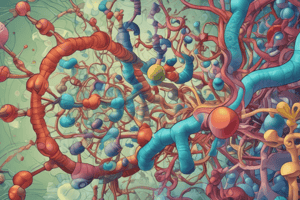Podcast
Questions and Answers
Which type of fat raises 'good' cholesterol levels?
Which type of fat raises 'good' cholesterol levels?
- Cis unsaturated (correct)
- Saturated
- Trans unsaturated
- None of the above
Which of the following is a food example of saturated fat?
Which of the following is a food example of saturated fat?
- Olive oil
- Butter (correct)
- Fish
- Vegetables
Which of these fats is known for raising 'bad' cholesterol levels?
Which of these fats is known for raising 'bad' cholesterol levels?
- All of the above
- Cis unsaturated
- Trans unsaturated (correct)
- None of the above
What type of molecule is a phospholipid?
What type of molecule is a phospholipid?
Which description applies to cholesterol?
Which description applies to cholesterol?
What is the general molecular formula for monosaccharides?
What is the general molecular formula for monosaccharides?
Which of the following are examples of hexoses?
Which of the following are examples of hexoses?
What type of reaction forms disaccharides?
What type of reaction forms disaccharides?
What type of bond holds two monosaccharide units together in disaccharides?
What type of bond holds two monosaccharide units together in disaccharides?
Which type of hemoglobin permanently binds to proteins after prolonged exposure to elevated blood sugar?
Which type of hemoglobin permanently binds to proteins after prolonged exposure to elevated blood sugar?
Which characteristic is NOT true of cis-unsaturated fats?
Which characteristic is NOT true of cis-unsaturated fats?
What distinguishes unsaturated fats from saturated fats?
What distinguishes unsaturated fats from saturated fats?
Which type of unsaturated fats is associated with cardiovascular diseases?
Which type of unsaturated fats is associated with cardiovascular diseases?
Flashcards are hidden until you start studying
Study Notes
Carbohydrates
- Monosaccharides are the basic unit of carbohydrates, composed of carbon, hydrogen, and oxygen atoms in a 1:2:1 ratio.
- They have the general molecular formula (CH2O)n, where n can be 3, 5, or 6.
- Monosaccharides can be classified according to the number of carbon atoms in a molecule:
- Trioses (n = 3): e.g., glyceraldehyde
- Pentoses (n = 5): e.g., ribose and deoxyribose
- Hexoses (n = 6): e.g., fructose, glucose, and galactose
Disaccharides
- Disaccharides are formed when two monosaccharides react through a dehydration/condensation reaction, releasing water and requiring energy.
- A glycosidic bond forms, holding the two monosaccharide units together.
Carbohydrates + Proteins
- Glycated Hemoglobin (HbA1C) is a type of hemoglobin that permanently binds to proteins like hemoglobin after prolonged exposure to elevated blood sugar.
- HbA1C is different from normal hemoglobin (Hb), which transports four oxygen molecules by binding to four iron atoms inside each HEME Group.
Fats
- Saturated fats have a maximum number of hydrogens bonded to the carbons, making them "saturated" with hydrogen atoms.
- Unsaturated fats have carbon-carbon double bonds within the fatty acid chain.
- Monounsaturated fats have a single double bond.
- Polyunsaturated fats have multiple double bonds.
Unsaturated Fats: Cis- and Trans-
- Cis-unsaturated fats:
- Usually naturally occurring
- Hydrogens are on the same side of the double bond
- Create a kink, making them more likely to be liquids at room temperature
- Trans-unsaturated fats:
- Manufactured
- Hydrogens are on opposite sides of the double bond
- No kinks, making them more likely to be solid at room temperature
- Associated with cardiovascular diseases
Cis Unsaturated, Saturated, Trans Unsaturated
- Cis unsaturated fats:
- Found in almonds, vegetables, fish, and olive oil
- Raise "good" cholesterol levels
- Saturated fats:
- Found in beef, butter, pizza, and ice cream
- Raise "bad" cholesterol levels
- Trans unsaturated fats:
- Found in cookies, donuts, cakes, and fries
- Raise "bad" cholesterol levels
Special Case: Phospholipid
- Amphipathic, with a hydrophilic "head" and hydrophobic "tail"
- Joined with a glycerol
- Form bilayers, e.g., cell membrane
Special Case: Cholesterol
- Lipid
- Amphipathic, with hydrophobic and hydrophilic regions
Studying That Suits You
Use AI to generate personalized quizzes and flashcards to suit your learning preferences.




